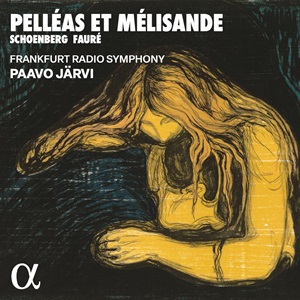
Pelléas et Mélisande: Schoenberg & Fauré
Arnold Schoenberg (1874-1951)
Pelleas und Melisande, Op 5 (1902)
Gabriel Fauré (1845-1924)
Pelléas et Mélisande, Op 80 (1898/1901)
Frankfurt Radio Symphony Orchestra/Paavo Järvi
rec. 2012, Alte Oper, Frankfurt, Germany (Schoenberg); 2016, hr-Sendesaal, Frankfurt, Germany (Fauré)
Alpha Classics Alpha 1058 [59]
It all began with the five-act play Pelléas et Mélisande by Belgian playwright Maurice Maeterlinck’s (1862-1949). Written in 1892 and premiered in 1893, it is regarded as a high point of French Symbolist drama, a genre popular in the late 19th century. It emphasised atmosphere, feeling and the numinous. Poetic language and abstract settings served to explore themes of spirituality, dreams and the subconscious.
The plays tells the story of a love triangle between Pelléas, Mélisande and Golaud, Mélisande’s husband and Pelléas’s half-brother. The backdrop is an imaginary medieval country. Reviewers noted how Maeterlinck prioritised atmosphere over plot in a “dreamlike fairy tale about the terrifying power of love”.
Over the years, the play inspired several composers. There is Claude Debussy’s operatic masterpiece and Jean Sibelius’s 1905 incidental music. Mel Bonis’s Mélisande is one of seven pieces in Femmes de légende for piano. The two works here are hugely different. Gabriel Fauré first wrote his incidental music for a London performance of the play in 1898. Arnold Schoenberg penned a tone poem in a full-blown late-Romantic style.
Fauré took under a month to devise twenty numbers of stage music. His pupil Charles Koechlin orchestrated the score in time for the play’s London premiere. Three years later, Fauré gathered various fragments to create the Suite of three movements: Prélude, Fileuse and La mort de Mélisande. Some years later, he added the famous Sicilienne, originally part of an “uncompleted stage music project”.
The Prélude sets a serious tone. Fileuse, a portrait of Mélisande’s spinning wheel, creates a filigree of movement. The Sicilienne, a depiction of the lovers’ short-lived happiness, has a charming melody, justifiably popular. La mort de Mélisande leaves one in a sad but thoughtful mood. Overall, Fauré has captured the story’s “mysterious, enchanted, cryptic” tempers. This is aided by sophisticated orchestration and a rich harmonic palette.
I discovered Schoenberg’s Pelleas und Melisande several years after meeting his atonal and dodecaphonic music. It came as a major surprise. This strong, romantic tone poem felt more Wagnerian or Straussian than the expressionist sound-world of Pierrot Lunaire, the string quartets or piano pieces with which I was familiar.
It was Richard Strauss’s suggestion that Schoenberg write a work based on Maeterlinck’s play. It was to have been an opera, but finally he decided to craft a tone poem. The critic Harry Neville summed up the creative process (sleeve note, EMI Angel S-36509): “Unlike the incidental music of Fauré and Sibelius, Schoenberg’s Pelleas is no mere delineation of character and atmosphere; in it the composer attempts not only to narrate musically the action of the drama, but to depict the psychological implications as well – all within the confines of a vast sonata form.”
Pelleas und Melisande is long, more than forty minutes, in a single movement divided up into eleven interrelated sections. Schoenberg wrote: “Aside from a few omissions and minor alterations in the sequence of scenes […] I tried to reflect every detail.” In fact, it is customary to analyse it as a symphony rather than a symphonic poem. Alban Berg noted that “in the four principal sections of this work we can even identify clearly the four movements of a symphony”. There is a sonata form, a scherzo, a slow movement and a rondo-like finale which recaps much that has gone before.
The tone poem is constructed from leitmotifs and themes associated with the main characters in the play. Schoenberg also employed musical tropes for the external forces at play: jealousy, fate, death and love. These are often superimposed with deft contrapuntal skill. Berg categorized twenty themes. Instrumental colouring identifies the characters: trumpet for Pelleas, horn for Golaud and cor anglais for Melisande.
The work’s premiere at the Musikverein in Vienna on 26 January 1905 caused great consternation amongst the audience and the critics. For those unacquainted with the piece, the stylistic markers are Wagner and Strauss, with hints of Mahler and Brahms. Yet, this is not a pastiche but a glorious synthesis of the received musical language of the late nineteenth century.
The playing by the Frankfurt Radio Symphony Orchestra under Paavo Järvi is faultless, the recording is ideal. Adam Gellen’s notes in German, English and French are essential reading.
The disc presents two wonderfully contrasting explorations of Maurice Maeterlinck’s Pelléas et Mélisande. Both are a pleasure to listen to.
John France
Buying this recording via a link below generates revenue for MWI and helps us keep free access to the site




















